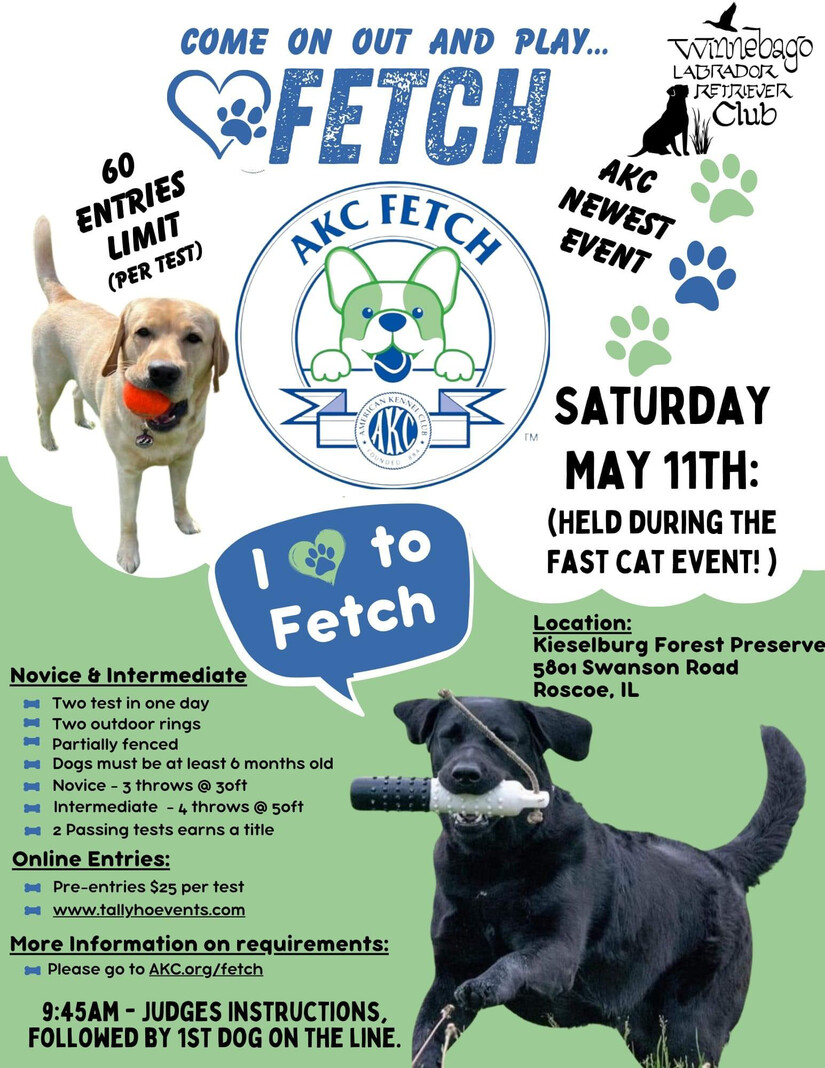All-Breed Fast Coursing Ability Tests (FastCAT)
Sat May 11 8:00 am, Keiselburg Forest Preserve 5801 Swanson Road Roscoe IL, 61073

Free. Sponsored by the Winnebago Labrador Retriever Club. Also includes the newest AKC Fetch competition.

Sure, you think your dog is fast. But have you ever wondered how fast? Well, you no longer have to wonder. FAST CAT® – which stands for Coursing Ability Test – is a timed 100-yard dash where dogs run one at a time, chasing a lure. It’s over before you know it — and it’s nothing short of awe-inspiring to watch your dog run at top speed, ears back, eyes focused, legs strong. Although it is a relatively new sport, its popularity has spread like wildfire. No wonder. According to one AKC official, “The FAST CAT® provides a terrific opportunity to introduce new participants to the world of AKC sports as one of the few events where all that is needed to compete is a dog’s natural instincts.”
Basic Information about AKC Fast Cat
1) Fast CAT Test is a timed straight 100 yard dash for dogs. It is meant to be
a fun and healthy activity of interest to any dog owner.
2) Dogs run singularly.
How are Fast CAT Points and Titles Awarded?
1) The dog’s time to complete the 100 yard dash is converted into MPS.
2) A handicap system is applied to a dog’s MPS to determine the number of
points earned. The handicap system is based on the height of the dog at
its withers.
a) 18 inches or greater = handicap of 1.0
b) 12 inches to less than 18 inches = handicap of 1.5
c) Below 12 inches = handicap of 2.0
3) Points = MPS multiplied by the dog’s handicap
4) Fast CAT titles are suffix titles earned at designated milestones.
BCAT = 150 points
DCAT = 500 points
FCAT = 1,000 points
FCAT = every additional 500 points
5) The top 20 fastest dogs by breeds are published on the AKC website.
Course and Equipment
1) Safety: Safety is of utmost importance. It is the responsibility of the event
committee to ensure the safety of the course, equipment and conduct of
those involved with the event. It is recommended that the event committee
run a test dog prior to the start of the event to ensure that the equipment
functions properly and all personnel understand their jobs. Prior to moving
the lure to position it for the start, the lure operator shall announce “hold
your dogs” in order to caution owners.
2) The Finish: The club must provide enough room for a safe run-out area.
WLRC will attempt to use a minimum of 50 yards. It is recommended an
owner or someone familiar with the dog be at the finish in order to catch the
dog once the course is completed. WLRC will attempt to provide assistance at the end of the course to collect the dogs if the owner requests it.
3) Timing Devices: WLRC will use electronic timers. The time to complete
the 100 yard dash is recorded to the nearest 1/100th of a second. The time
starts when any part of the dog breaks the electronic beam at the start line.
The time stops when any part of the dog crosses the finish line. Stop
watches will be used as a backup if the electronic timers don’t function. In
the event of manual timing, a starter’s flag will signal the start when the
dog’s nose crosses the starting line and the time will be recorded by two
timekeepers, each operating individually, at the finish line. The time will be
the mathematical average of the two manually recorded times.
4) Lure Equipment: WLRC uses a drag line system. The lure is propelled by
a DRAG LURE SYSTEM whereby the lure, consisting of a squawker-type
lure or plastic lure dragged along the ground in front of the dog by a take-up
reel. There is no trailing-line for the dog to step on or get caught in. At the
end of the run, the lure is propelled back to the starting line by a separate
mechanical system and replaced at the starting position prior to the next
run. Safety is the number one consideration in running this event.
5) Field Conditions. The field is reasonably flat, level and mowed. The
actual running area is approximately 150 yards long x 5 yards wide, with a
cloth/plastic type barrier. The release line is ten feet behind the starting line.
The course is 100 yards long with finish line timers (electronic or manual)
and a 50-yard run-out area. Handlers may not walk the course with their
dogs during the actual test, but they may walk the course to the catch area
BEFORE their dog is released.
6) The huntmaster has control of the course. The huntmaster is in charge of
all dogs and handlers on the field, shall ensure handlers understand safe
release and retrieval procedures, shall ensure the lure is properly
positioned, shall ensure the lure operator, timers and starting line signal
person are ready, shall signal the lure operator to start the lure and shall
give the verbal signal “tallyho” to release the dog.
7) For handlers with multiple entrants: Please indicate that your dogs
should be separated in the running order.
8) Check in and Inspection: Dogs must be checked in and inspected prior
to each run. Inspection will check for general fitness and for females in
season, which are not permitted to run. In addition, the dog’s handicap
must be verified at the time of inspection. You will receive a card at
inspection that will be turned in to the Paddock Master.
9) At the line: The Paddock Master will coordinate the running of the dogs
according to his/her best discretion. Each exhibitor will receive a running
order via e-mail prior to the event. The schedule will also be posted in the
inspection/paddock area. Dogs will be called “to the line” and “in the hole”
positions. Dogs that are not present “in the hole” will be moved down and
the next available dog will be inserted into the running order to keep things
moving. The missing dog will be inserted into the running order as
convenient when they arrive. So, if you miss your run time, you will not be
required to wait until all the dogs have run. You can run, within reason,
when you arrive.
10) Operation of the Lure: The Lure Operator’s job is to 1) ensure a safe run
by operating the lure correctly, and 2) to get the best score for your dog. If
your dog is new to the sport, tell the Huntmaster! That may mean operating
the lure differently, to get his/her attention, as opposed to an experienced
dog that needs little to no encouragement. If your dog is particularly fast for
it’s breed, simply advise the Huntmaster about your “Fast Dog.” They will
tell the lure operator, who will adjust the running of the lure to accommodate
this. The lure operator has experience and knowledge related to running
various breeds, but every dog is different. We want you to have a good
score.
11) Schedule and Trial Hours: 8am until all runs are completed or 3pm,
whichever comes last. Note in the event of inclement or other conditions or
to assist with timely completion of the trial, Trial Committee may elect to
start the events earlier than posted. In any event, all entrants present
during the posted times will be allowed to run, if conditions are safe.
General:
1. All entries must be one year of age or older on the day of the
test or trial.
2. Dogs not present by the end of the test will be scratched.
3. Each entry will be examined at inspection. Inspection shall
take place prior to any form of wrapping being applied to the
dog. In the opinion of the inspection committee, any entry
found to be lame, unfit to compete or a female in season shall
not be allowed to enter and entry fees shall be refunded.
4. Dogs will be inspected before each Event.
5. Run order will be based on order set by the field committee.
We will separate the running of multiple dogs handled by a
single handler. If a dog is late for their run time they will run
at the end of the running order.
6. Dogs may wear any collar except a choker collar, a
harness, a collar with prongs or an electronic training
collar. The collar should be snug to minimize the chances
of getting hung up on something during the run. Owners
should be aware that there is a chance that tags hanging
from the collar could become entangled on something
during the run. Owners may use clips or rubber bands to
hold the dog’s hair. The owner assumes responsibility for
the safety of the dog with regard to the dog’s collar and
paraphernalia on the dog.
7 Drag line system will be used. Lure is a white plastic bag
or a squawker.
8. The field committee reserves the right to bar known
aggressive dogs from the event site.
9. There will be a $5 fine assessed for any loose dog not
taking part in the course in progress, or for anybody
caught not picking up after their dog, or leaving garbage
on the field.
10. No one will be allowed on the field without the express
permission of the field chairman, except the appointed
field committee.
11. Anybody exhibiting unsportsmanlike behavior will be
excused from the field and may be subject to further
disciplinary action.
12. Control of dogs strictly enforced, on leash at all times
except when running.
13. Clean up and carry out all trash.
14. Please pick up after your dog and put in receptacles
provided at site.





